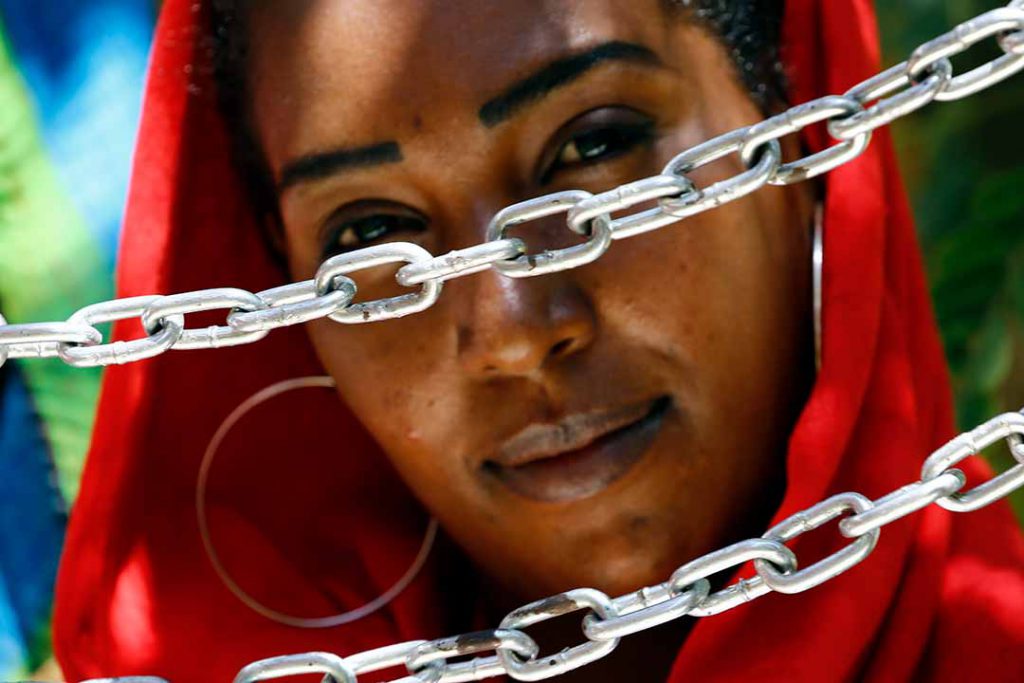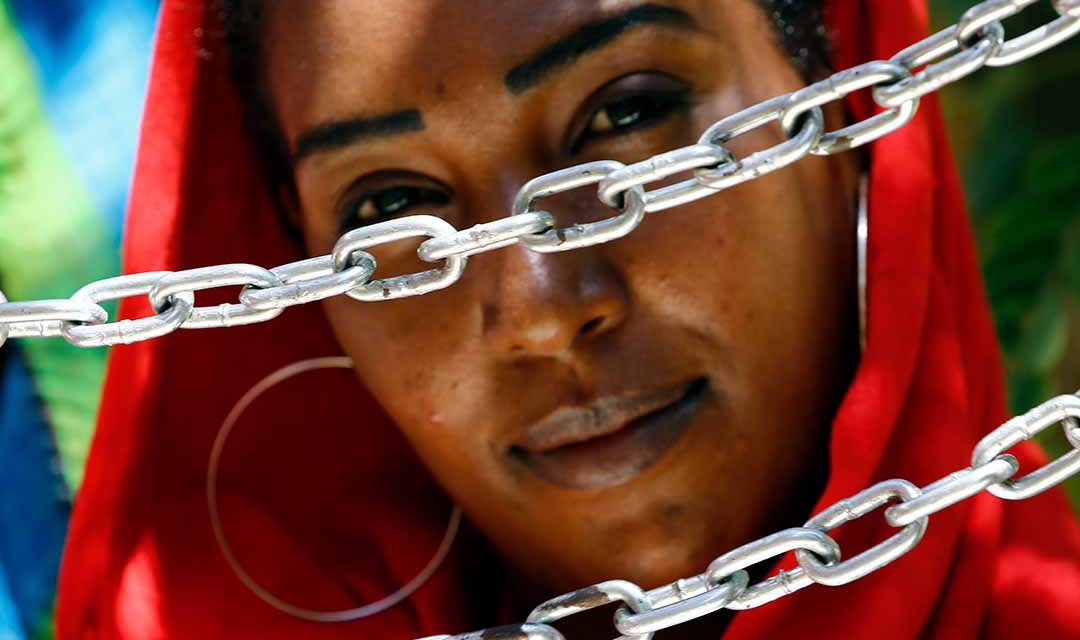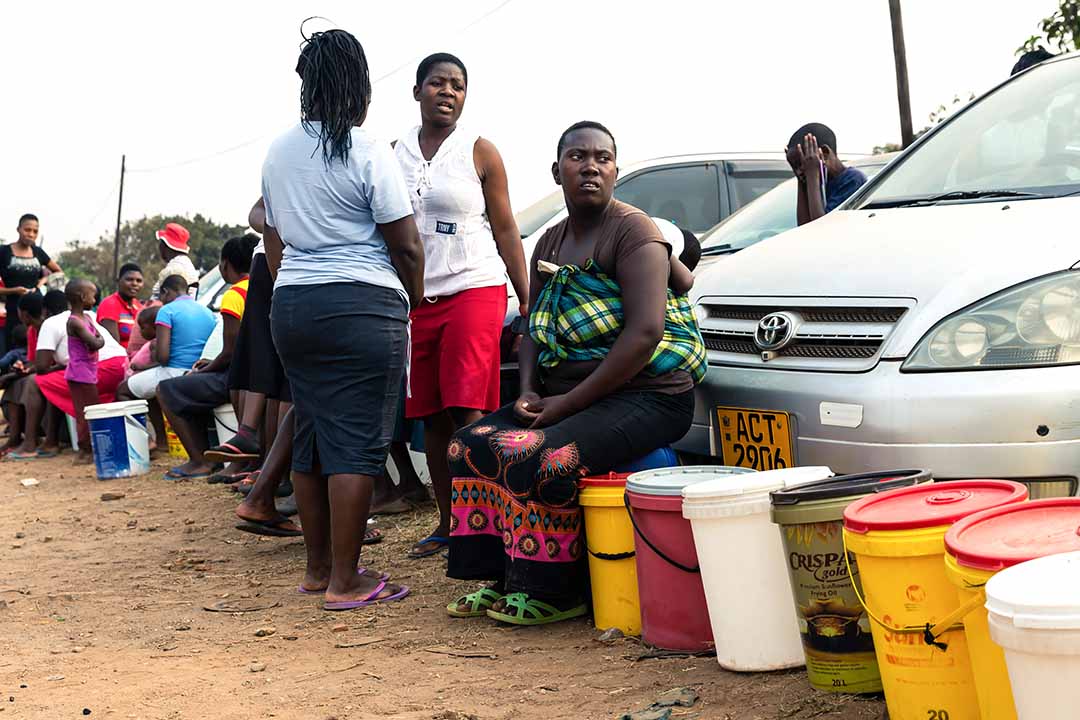African media: where to?
High data costs, internet shutdowns, fake news and constant technological disruptions are plaguing Africa’s media. Yet many in the sector are hopeful

A Sudanese journalist poses with chains outside the Tayar newspaper in Khartoum to mark a hunger strike by journalists on 1 March, 2016 to protest the decision to withold publication of the newspaper Photo: Ashraf Shazly / AFP
Across the African continent, media are looking at ways to remain relevant in an age when technological disruptions have upended the business models for the sector. They are not alone. The Reuters Institute 2019 report on journalism, media and technology trends, as well as its report on predictions for 2020 released in January this year, sketches a challenging time ahead for media operations everywhere.
According to the 2020 report, mobile and social media are disrupting traditional approaches to journalism and media operations by fragmenting audiences’ attention, undermining advertising-based business models and weakening the role of journalistic gatekeepers. Add to that low levels of trust amid a plethora of fake news. Many of the industry executives interviewed for Reuters’ predictions for 2020 were confident about their own company’s prospects, but much less sure about the future of journalism.
The research is clear that if digital media are to be sustainable, media houses across the world – including those based in Africa – will have to work hard to find the revenue streams that matter. Some 50% of the executives interviewed on their predictions for 2020 said they had identified reader revenue as their major income stream for the coming years. That means more paywalls and subscriptions and membership models. Other models include advertising, but few of the executives believed that media could compete with the tech platforms, particularly given that Facebook and Google take the lion’s share of internet income.
How true is this for Africa? Southern and eastern Africa are seeing some developments with regard to digital media formats, but the continent still lags in terms of ease of payment. Digital media are, of course, dependent on the internet, but as of mid-2019, about 40% of Africans, or around 525 million users, had access to the internet, according to figures provided by the online source, Internet World Stats. However, levels of access vary around the continent, with around 1% of the population in Eritrea having access, single figures in the Great Lakes region, and almost 90% in Kenya.
Africa is a diverse continent with social, economic, political and cultural differences not only between regions, but also within regions. As WAN-IFRA vice president Lisa MacLeod points out, Africa is not a “generic continent”. Despite the continent’s variety, though, she says that “the one thing people around the continent are collectively embracing is mobile media”. In East Africa, Churchill Otieno, Nation Media Group’s digital managing editor and chairman of the Kenya Editors Guild, notes that young audiences depend almost entirely on digital media for information and entertainment.
“Legacy establishments are working hard to stay relevant, but most of their interventions are challenged,” he notes. This changing structure has led to changes in the way information is acquired and published – including the emergence of new media roles, such as influencers and bloggers, who are often used as first sources of information, even if their information is often misleading. Dapo Olorunyomi, Publisher and CEO of the Premium Times newspaper based in Abuja, Nigeria, says access to the internet in West Africa has seen “relative growth” which, along with the availability of smartphones, has driven growing use of social media in the region.
According to the Broadband Commission Report released last year, 29% of Nigeria has broadband access while more than 111 million Nigerians had access to the internet by the end of 2018. WAN-IFRA Women in News Africa Director Dr Tikhala Chibwana describes Africa’s efforts as a “mixed grill”. Provision of content through digital media in Africa has seen “quite a positive uptake” on the part of media organisations, though their capacity to do so depends on the size of the organisation. “Bigger organisations have been able to do a lot more, because they already have a digital presence,” Chibwana told Africa in Fact.
Many African media houses, especially those with print backgrounds, have seen their circulation numbers declining, he said. “It’s not as dramatic as what has happened in Europe or in America, but still, income from circulation is dwindling and the challenge is there’s not a corresponding amount coming from digital,” Chibwana notes. Given this uncertainty, some media organisations were “still trying to figure out what they need to do next”, he says, or experimenting. Meanwhile, consumers are moving into the digital space, but advertisers have been slow to follow. Some are also using social media to reach their audiences directly, but getting people to pay for content is a challenge.
Many media consumers worldwide still expect to access free information, and Africa is little different in this regard. As a result, Olorunyomi says, some media houses are turning to donor-funded news gathering models, most often to support investigative journalism. This has had a “huge impact” on the stories being told, he says. As regards general funding models in West Africa, though, he believes that that while donor funding helps, the commercial model is still the significant model of both advertising and in circulation, while event hosting can also bring in some extra income.
Though, reading between the lines, this approach might already be outmoded. “The sad part is that it’s clear that advertising is really decreasing,” Olorunyomi adds. Some Nigerian publications such Business Day are shifting towards online payments for subscriptions, but others have had to backtrack. Currently, the thinking is that a mixed model will be needed, which includes free and paid for content, as well as commercial and donor funded income streams, he adds. However, as if these commercial pressures were not enough, African media owners also face potential state control, including shutdowns.
Ironically, the internet itself makes this possible. Zoe Titus, a strategic co-ordinator at the Namibia Media Trust, says internet shutdowns across the continent are a cause of concern. Aside from this, African media are facing other challenges: “We see more violations against the media … not just by state activists but also non state actors. We are seeing less tolerance of the role of the media,” she says. Development NGO the Panos Institute Southern Africa (PSAf) executive director Vusumuzi Sifile agrees. Governments around the continent are tightening media regulation or policing of the digital space through the enactment of cyber legislation, he says.
“Government representatives claim that cyber legislation is intended to protect citizens from fake news and unscrupulous online dealers, but stakeholders are concerned the cyber legislation may contribute to state-sanctioned infringements of citizens’ digital rights. This could potentially disrupt the growth of digital media around Africa,” Sifile adds. For some media operations, donor-funded investigative journalism is offering short-term respite, as is sponsored content. But the growth of sponsored content is, in turn, putting pressure on the media’s traditional strict separation of editorial content and advertising.
In many cases, African media houses are using converged structures in their newsrooms, says Otieno – which means that they are relying on small central editorial operations to control multiple publications. In East Africa, grant- and donor-funding is still nascent, he adds. In that region, media “find themselves in a vicious cycle of cost cuts, resulting in weaker products, which in turn limits investment in the sector”.
While donor-funded journalism is fulfilling a critical need, it also raises concerns, says Dr Admire Mare of the Department of Communication at the Namibia University of Science and Technology. “The problem that it brings is dependency… I would say that in this current context, with these unstable business models gutting our operations, donor-funding must be seen as one of many [possible] income streams.” So how sustainable is Africa’s digital media future? Media houses are experimenting with digital media platforms and opportunities, but “there are still some missing dots”, says Sifile.
In his view, digital media are not yet functioning in ways that consumers in the region find useful. “As a result, a significant part of the population still relies on the traditional print and broadcast media.” African media operators are well aware that digital is the future, says Otieno. “There seems to be a certain appreciation that the solution is somewhere in the digital space. The audiences have migrated there anyway. Many are now seeking ways to monetise that audience.” But as MacLeod observes, levels of consumption of digital media depend on the audience.
“Affluent Africans are huge consumers of digital media, particularly through mobile devices,” she notes. And they often consume international media, not only local media. Meanwhile, people living at the lower LSM levels are often restricted, not just by the cost of hardware, but also the cost of data. Given these challenges, African media owners have sometimes been “ahead of the curve”, for example, by moving to mobile digital content offerings that avoid the problems associated with the widespread lack of infrastructure and limited access to desktops and laptops. What does this mean for business models?
MacLeod says that some media operations are shifting away from click-driven advertising to media models based on addressing people’s sense of community. Regional differences across the continent mean that media houses will identify different opportunities for monetisation, which might include hard paywalls, payment-per-story and advertising initiatives such as funded storytelling (native advertising). African media markets are in a “distressed state”, says Bilal Randeree, Program Director for Africa & MENA of the Media Development Investment Fund (MDIF), a New York-based, not-for-profit that invests in independent media.
Nevertheless, he says the continent is seeing “interesting developments”. Media houses represent a diverse media landscape with quite a mixture of different kinds of products, he told Africa in Fact. But the move to digital media is particularly constrained by Africans’ relatively limited access to the internet. Successful media operations find ways to add value, he says. “If you are a niche publication providing clear value to your audience, they become loyal. You reach an audience with a very specific product and a clear value offering.”
According to a 2019 report by Germany-based DW Akademie, an organisation that sponsors media development, the ongoing digital disruption of traditional revenue streams is also affecting newspapers in emerging democracies, including those in sub-Saharan Africa. Some 36% of newspapers in emerging democracies had no internet revenue, according to a survey by the World Association of Newspapers and News cited by the report. Yet, says the organisation, “media viability goes hand in hand with free expression”.
Successful media operations, and in particular good investigative journalism, are therefore also important to the development of democracy around the continent, says Titus. Chibwana agrees. While the current situation for media is difficult, “people are beginning to realise you cannot rely on social media, [so] there is a place for professional media,” he told Africa in Fact. Otieno predicts shorter-term pain for the media sector across Africa with longer-term potential. “Out of the embers,” he concludes, “new giants will emerge.”
Paula Fray is a leading media trainer and coach who works across Africa and the Middle East. The former regional director for Inter Press Service Africa, she is the CEO of the pan-African communications company frayintermedia, which has worked to improve the quality of journalism in Africa since 2005.













